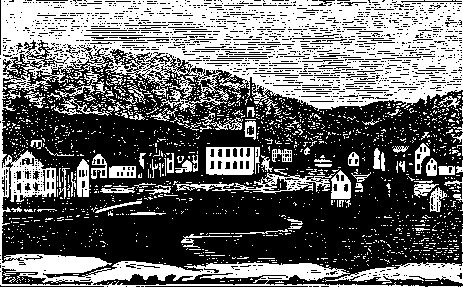
From Torrington we enter the town of Winchester, which was laid out by Hartford in 1732. The name was taken from Winchester in England. The region was remote, and the first settler did not arrive until 1750; town privileges were granted in 1771. Winchester is a broken hill country, the elevations ranging from 700 to over 1500 feet. It is in the Greenwoods section of the State, with abundant hemlock and pine. The town is noted for its laurel display, and an annual Laurel Drive is marked out in June.
Winsted was chartered as a borough in 1856 and as a city in 1915, and in 1930 had a population of 7,883. The name was a combination of Winchester and the neighboring town of Barkhamsted. It lies in a pocket of the hills, at the junction of the Mad and Still Rivers, which supply good waterpower. The Winsted Mfg. Co. has been making scythes since 1792, probably the oldest manufacturing concern in the State. The forerunner of the Wm. L. Gilbert Clock Co. started in 1807, making it the oldest of the present clock-making establishments in Connecticut. Among other important products are electric appliances, hardware, edge tools, silk thread, hosiery and underwear.

Southwest of Winsted is the beautiful Highland Lake, with 9 miles of shore front, encircled by Wakefield Memorial Boulevard. About 3 miles from the center and 1/4 mile west from the lake shore is an old Indian Chipping Ground, or arrow factory. Climbing above the Lake by Boyd St. and Platt Hill Rd., with good views and the attractive Crystal Lake to our right, we reach Platt Hill and Far View picnic ground (open for a small charge) one of the points on the annual Laurel Drive, with a remarkable view in almost all directions. We look down on Highland and Crystal Lakes, and on a clear day can see the Catskills, Mt. Greylock in Massachusetts, and Long Island Sound.
The small village of Winchester Center, with its elm-shaded Green, lies about 4 miles southwest of Winsted. Northwest of the village, on the Norfolk road, is the new Lake Winchester. To the southwest, we find Owleout Hill, best reached from R. 49, with a fine view and the remains of an Indian lookout. Chief Owleout was buried here. Going south on R. 49, and taking Hall Meadow Rd. in the southwest corner of the town, an old chimney marks the home of the first settler, Caleb Beach, in 1750.
West of the city on R. 101, we pass on the right the foundations of an old Tollgate house, on the route of the Greenwoods Trirupike, completed in 1799. It ran from New Hartford to the Sheffield line, passing through Winsted and thus diverting travel that formerly went by Winchester Center. This highway continues to Norfolk. R. 183, which turns north to Colebrook, makes a scenic drive, passing on the right in about 1 mile the Jonathan Coe House, built in 1791, a station on the "underground railway."
Going north from Winsted, Spencer Hill Rd. passes a good viewpoint in 1 mile, and nearby on the left is Second Cobble, 1200 feet, from which one can see the dome of the Capitol in Hartford. Continuing on Spencer Hill Rd., we reach the picturesque Rowley Pond.
There are scenic drives on U. S. 8 up Still River, and by the fork on R. 20 to Riverton. The traveler should note the old Grist Mill on the River, as he leaves tlie city, still doing business with millstones and waterwheel.